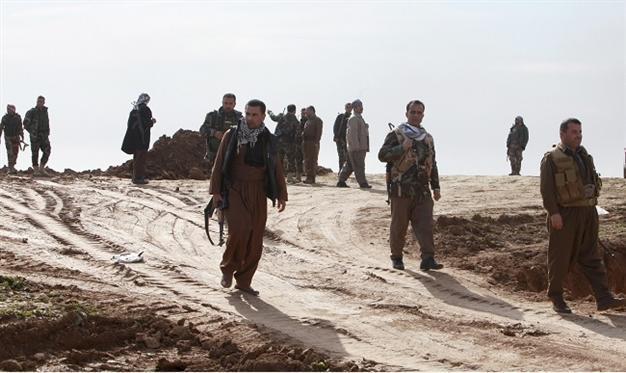US training 3,600 in Iraq but Syrian forces need more time
WASHINGTON - Anadolu Agency

Kurdish Peshmerga fighters are seen during the battle with Islamic State militants on the outskirts of Mosul January 21, 2015. Kurdish forces in northern Iraq said on Wednesday they had cleared Islamic State insurgents from nearly 500 square kilometres of territory and broken a key IS supply line between the city of Mosul and strongholds to the west near Syria. REUTERS/Azad Lashkari
The Pentagon confirmed Jan. 23 that it has begun training 3,600 Iraqi and Kurdish forces, but has yet to begin recruiting and actively vetting their Syrian counterparts.In Iraq, the U.S. and coalition partners have begun training forces at four sites across the country, including al-Assad, Camp Taji in Baghdad Governorate, Bismaya and Erbil.
The Erbil site became active Jan. 23, and is currently training roughly 100 peshmerga forces.
"As of today all four of them now have trainees, and training is ongoing at all four," Pentagon press secretary John Kirby told reporters.
In addition to the 100 forces being training at the Erbil site, 600 are training at al-Assad, 1,600 at Camp Taji, and 1,300 at Bismaya.
The Islamic State of Iraq and the Levant (ISIL) group is currently assessed to have between 20,000 and 30,000 fighters in its ranks, Kirby said, adding that the range varies because ISIL's ranks are constantly fluctuating.
That's minus an estimated 6,000 that Gen. Lloyd Austin told the Wall Street Journal had been killed by U.S. airstrikes.
Aside from unpopulated or strategically unimportant areas, ISIL is in control of roughly 34,000 square miles (55,000 square km) in Iraq, compared to 48,000 square miles (77,000 square km) held by the central government and 35,000 square miles (56,000 square km) held by Kurdish forces, Kirby said.
Training for Syrian forces, which will take six to eight months to produce fighters ready to go back to Syria once it begins, is unlikely to begin before spring, according to Kirby.
"If everything continues to go on track, you're looking at units, groups that are trained, and able to go back into Syria, probably near the end of the year in the fall," he said.
By developing a cadre of skilled leaders, the U.S. is hoping that it can boost the meager forces of the moderate Syrian opposition.
"When you have good leaders you tend to draw more followers, and you can potentially build more recruits, and the vetting continues to go from there," Kirby said.
















